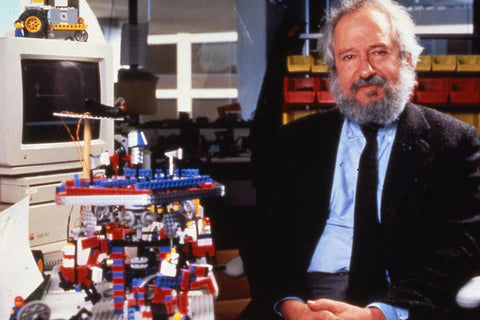
Courtesy of SPA Magazine/Courtesy of MIT Media Lab
Seymour Papert (1928-2016) was a mathematician and considered both the father of artificial intelligence and educational computing.
Papert was born in South Africa, where he studied Philosophy and later completed a PhD in mathematics. Seymour Papert was also an anti-apartheid activist throughout his education, after meeting Nelson Mandela.
For his second PhD, Papert worked with renowned psychologist Jean Piaget, learning how children learn. He later stated ‘Piaget’s work gave me a new framework for looking at the gears of my childhood’.
Papert is considered a pioneer of artificial intelligence. Papert later co-founded the Artificial Intelligence Lab at MIT (Massachusetts Institute of Technology) in the 1960s and MIT’s Media Lab.
With Dr. Minsky, Dr. Papert wrote ‘Perceptrons: An Introduction to Computational Geometry’, considered an important book on artificial neural networks.

He developed Logo (1967), the first programming language for children. The ‘Logo turtle’ was a turtle robot which kids could program.
Papert was a visionary educator. He later wrote his famous ‘Mindstorms: Children, Computers and Powerful Ideas’ (1980s) where he argues technology could support children’s learning.
Classrooms in the 1970s were full of pencils and papers, and Papert imagined a future where every child has access to a computer, to support their learning.
At MIT, Papert collaborated with LEGO, and became the first ‘MIT Lego Professor’. This happened by chance, where the former President of LEGO, Kjeld Kirk Kristiansen, saw Papert on TV talking about LOGO turtles.
MIT and LEGO have since maintained a close relationship. Fun fact: LEGO’s Mindstorms is named after his seminal book!
"The role of the teacher is to create the conditions for invention rather than provide ready-made knowledge"
He developed a theory called ‘constructionism’, based on Piaget’s constructivism. Constructionism suggests that people learn most when they are actively constructing things around them (learning through making, i.e. building a sand castle).
His wife Susan Massie, states ‘He had the curiosity, openness and desire to learn of a child’.
What do you imagine the future of schools will look like? How will children learn? What will they learn?

